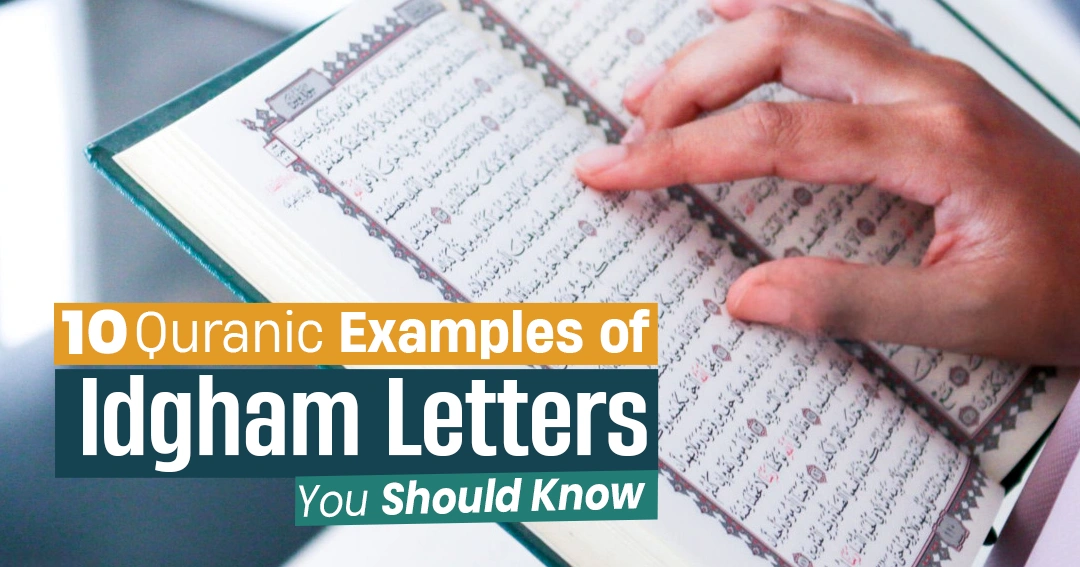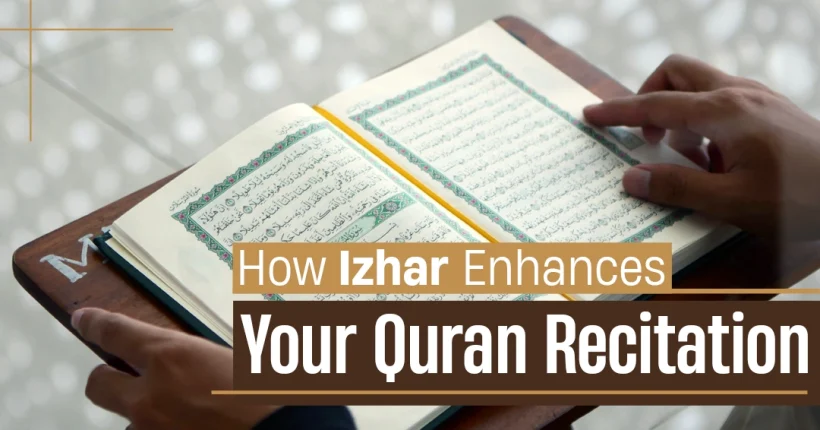Idgham letters with examples from Quran are essential for anyone aiming to improve their Tajweed and recite the Quran with clarity and beauty.
Whether you’re just starting your journey or brushing up on the rules, understanding how and when to merge letters can transform your recitation. In this article, we’ll explore 10 powerful examples from the Quran that will help you master Idgham and boost your confidence in every verse.
What is Idgham in Tajweed?
In the Arabic language, the word “Idgham” means insertion or merging. In the science of Tajweed, it refers to the merging of a non-voweled letter (like Noon Sakinah or Tanween) into the next letter when specific conditions are met.
By studying Idgham letters with examples from Quran, you’ll begin to recognize where and how this merging happens in actual verses, making your recitation sound more natural and accurate.
When Does Idgham Occur?
Idgham occurs when a Noon Sakinah (نْ) or Tanween (ً ٍ ٌ) is followed by one of six specific letters. These idgham letters are:
ي – ر – م – ل – و – ن
By learning Idgham letters with examples from Quran, you’ll be able to spot them during your recitation and apply the correct rule without hesitation. This is why many learners find it helpful to study these rules in context, rather than just memorizing them in theory.
The Idgham Letters

There are six Idgham letters. When Noon Sakinah (نْ) or Tanween (ً ٍ ٌ) comes before any of these six letters, Idgham occurs. The six Idgham letters are:
ي – ر – م – ل – و – ن
(Ya – Ra – Meem – Laam – Waw – Noon)
An easy mnemonic to remember them is the Arabic word: “يرملون” (Yarmaloon)
To practice the Idgham letters with examples from Quran first, you should understand that these six letters are divided into two categories:
1. Idgham with Ghunnah (nasal sound) – With nasalization
These letters require a nasal tone while merging:
ي (Ya)
ن (Noon)
م (Meem)
و (Waw)
Example: “مِنْ وَالِدٍ” → merge Noon into Waw with nasalization.
2. Idgham without Ghunnah (no nasal sound) – Without nasalization
These letters are merged smoothly, but without a nasal tone:
ر (Ra)
ل (Laam)
Example: “مِن رَّبِّهِمْ” → merge Noon into Ra without Ghunnah.
10 Quranic Examples of Idgham Letters You Should Know

Below are 10 Quranic Idgham letters with examples from Quran that every learner should know:
1. Idgham with Yaa (ي)
Surah Al-Baqarah (2:2)
ذَٰلِكَ الْكِتَابُ لَا رَيْبَ ۛ فِيهِ ۛ هُدًى لِّلْمُتَّقِينَ
Here, the Tanween at the end of “هُدًى” is followed by Laam, an Idgham letter. The sound merges smoothly without a pause.
2. Idgham with Noon (ن)
Surah Al-Ikhlas (112:2)
اللَّهُ الصَّمَدُ
لَمْ يَلِدْ وَلَمْ يُولَدْ
وَلَمْ يَكُن لَّهُ كُفُوًا أَحَدٌ
In “يَكُن لَّهُ,” the Noon Sakinah (نْ) is followed by Laam, leading to Idgham without Ghunnah.
3. Idgham with Meem (م)
One of the Idgham letters with examples from Quran is in Surah An-Naba (78:38)
يَوْمَ يَقُومُ الرُّوحُ وَالْمَلَائِكَةُ صَفًّا
Notice the merging of Tanween from “صَفًّا” into “يَوْمَ” showing Idgham with Ghunnah using Meem.
4. Idgham with Waw (و)
Surah Al-Fajr (89:15)
فَأَمَّا الإِنسَانُ إِذَا مَا ابْتَلَاهُ رَبُّهُ
In “الإِنسَانُ إِذَا,” the Noon Sakinah is followed by Alif (not an Idgham letter), but look at the next part “مَا ابْتَلَاهُ رَبُّهُ” where rules of merging can also apply in other contexts when Waw follows Noon Sakinah.
5. Idgham with Laam (ل)
One of the Idgham letters with examples from Quran is inSurah Al-Fatihah (1:7)
غَيْرِ الْمَغْضُوبِ عَلَيْهِمْ وَلَا الضَّالِّينَ
The Tanween at the end of “عَلَيْهِمْ” merges into Waaw, an Idgham letter with Ghunnah, enhancing the sound flow.
6. Idgham with Raa (ر)
Surah Al-Qamar (54:17)
وَلَقَدْ يَسَّرْنَا الْقُرْآنَ لِلذِّكْرِ
Here, “يَسَّرْنَا” shows a perfect blend of Idgham with Raa, requiring no nasalization (Idgham without Ghunnah).
7. Idgham with Ghunnah: Example 1 – Noon + Meem
One of the Idgham letters with examples from Quran is in Surah Al-Muzzammil (73:20)
إِنَّ رَبَّكَ يَعْلَمُ
The Noon in “إِنَّ” merges with Meem in the following word (if applicable), showing nasalization with Ghunnah.
8. Idgham with Ghunnah: Example 2 – Tanween + Yaa
Surah Al-Baqarah (2:3)
وَيُقِيمُونَ الصَّلَاةَ وَمِمَّا رَزَقْنَاهُمْ يُنفِقُونَ
In “رَزَقْنَاهُمْ يُنفِقُونَ,” there’s a clear Idgham with Ghunnah where Tanween merges into Yaa.
9. Idgham without Ghunnah: Example 1 – Noon + Laam
Surah Al-Lail (92:19)
الَّذِي يُؤْتِي مَالَهُ يَتَزَكَّى
In this type, there’s no nasal sound. When Laam follows Noon Sakinah or Tanween, the merging is quick and clear.
10. Idgham without Ghunnah: Example 2 – Noon + Raa
Surah Al-Fil (105:5)
فَجَعَلَهُمْ كَعَصْفٍ مَّأْكُولٍ
When the Idgham letter is Raa, as in many other verses, the Noon Sakinah merges without any nasal sound.
Common Mistakes to Avoid When Applying Idgham

Even with a strong understanding of Idgham letters with examples from Quran, students tend to make small but potent mistakes when using this rule while reciting. Identifying these errors early allows you to recite more accurately and with confidence.
1. Forgetting to Merge the Sounds
The most common of all is not blending Noon Sakinah or Tanween with the following Egham letter. As an example, with the verse “مِنْ رَبِّهِمْ,” students can sometimes pause between the Noon and Raa unnecessarily instead of blending them smoothly.
Practicing Idgham letters with examples from Quran will familiarize your ear to detect and correct this mistake.
2. Using Ghunnah When It’s Not Required
The majority of students mistakenly apply a nasal sound (Ghunnah) on Idgham letters like Laam and Raa, whereas they require Idgham and not Ghunnah.
The most important tip is to memorize the letters that need Ghunnah and which ones do not, and above all, to listen to them done correctly in real recitation. This is precisely the reason why learning Idgham letters with examples from Quran under an experienced teacher is of utmost significance.
3. Not Applying Idgham at All
Some students skip the rule entirety for fear of mistakes. Remember, failure to use Idgham when needed can distort your recitation’s rhythm—and sometimes even sense. That is why exposure to Idgham letters with examples from Quran with real-time feedback proves precious.
Avoid These Mistakes with the Right Guidance
Avoiding these mistakes is not something that happens overnight, but with expert guidance, it is much easier.
At Tareequl Jannah Academy, learners benefit from structured Tajweed programs focusing on practical application. You’ll practice Idgham letters with examples from Quran within every session so that your recitation is perfect and beautiful.





